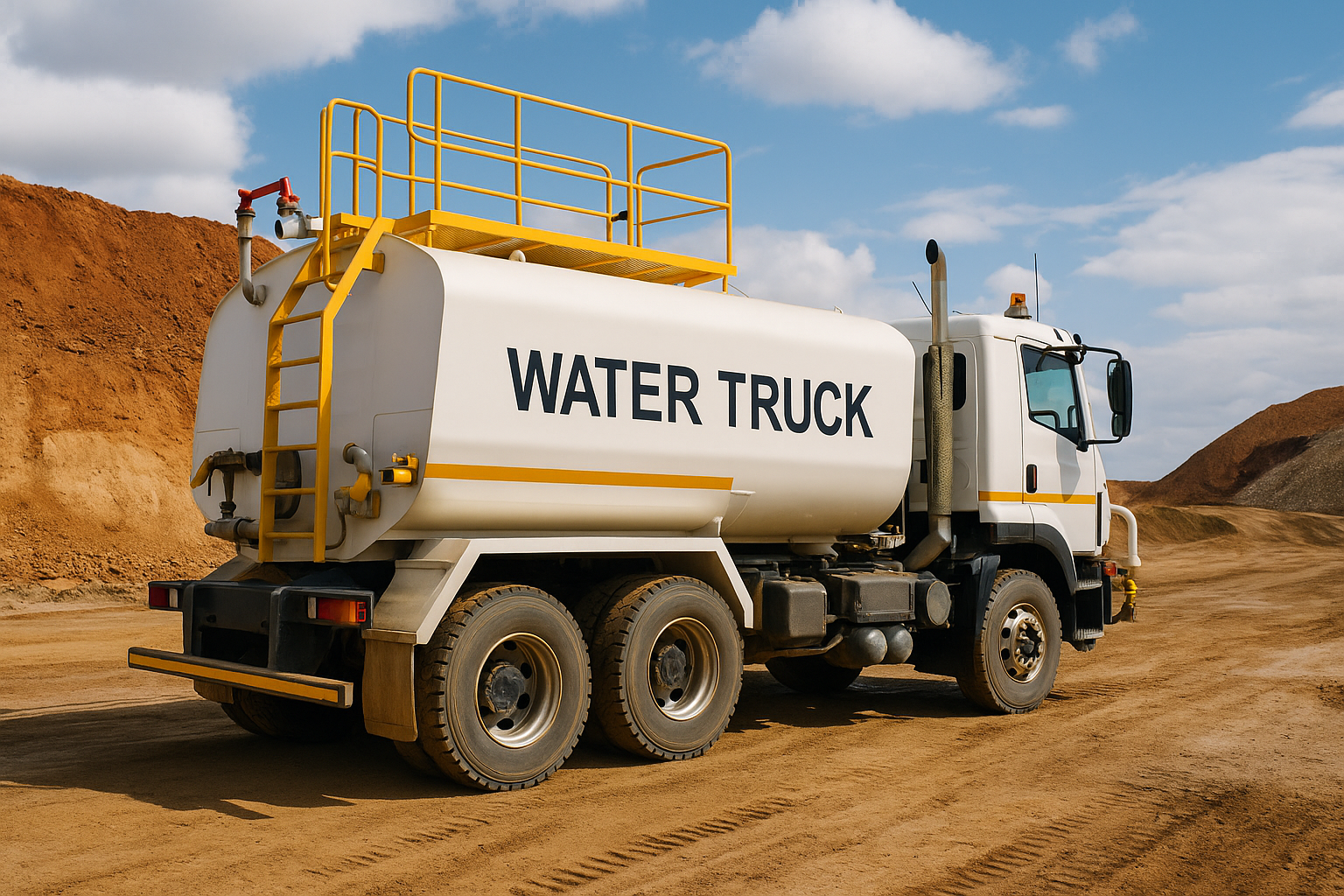In both mining and civil construction, dust control and water distribution are critical to maintaining safe, productive worksites. The choice of water trucks can make or break efficiency, and selecting the wrong configuration often leads to unnecessary downtime, higher operating costs, or even safety issues.
Whether you’re a project manager, procurement officer, or site supervisor, knowing how to spec water trucks correctly ensures you get a vehicle that suits your operation. Here’s a comprehensive guide to the key factors to consider when selecting the right truck for mining and civil works.
Step 1: Identify the Primary Purpose
Modern water trucks are versatile and used for several applications, including:
- Dust suppression – Keeping haul roads and civil sites safe and compliant.
- Soil compaction – Providing consistent moisture levels for earthworks.
- Fire control – Serving as on-site emergency units in high-risk areas.
- General water transport – Delivering water to remote or temporary locations.
Before spec’ing a truck, define whether dust control, compaction, or multi-use capability is your primary driver. For example, a mine site prioritising dust suppression on long haul roads will need a different setup than a civil contractor focused on road compaction.
Step 2: Choose the Right Tank Size
Tank capacity is one of the biggest decisions in specifying water trucks. It determines how much ground you can cover before needing to refill.
- Small trucks (5,000–9,000 litres) – Ideal for tight urban civil works, smaller sites, or when frequent refills are not a major concern.
- Medium trucks (10,000–15,000 litres) – Common in road construction and subdivision works, offering a balance between manoeuvrability and coverage.
- Large trucks (16,000–30,000 litres or more) – Typically used on mining haul roads where long, wide areas require constant dust suppression.
Tank size must match the water source availability, refilling infrastructure, and site access. Bigger isn’t always better - oversized tanks on civil sites may reduce manoeuvrability and increase wear on access roads.
Step 3: Select the Suitable Chassis
The performance of water trucks depends heavily on the chassis. Consider:
- On-road vs. off-road duty – Civil works may only require highway-rated trucks (Isuzu, Hino, etc.), while mining demands off-highway chassis (Caterpillar, Komatsu, etc.) designed for rugged conditions.
- Axle configuration – 6x4 and 8x4 setups are common for civil, while 6x6 or larger off-road models are essential for heavy-duty mining environments.
- Engine power – Ensure sufficient horsepower to handle full tank loads on steep grades or soft ground.
The wrong chassis can limit productivity, particularly if the truck struggles to carry its load over the terrain.
Step 4: Pump and Spray System Design
The water delivery system is what transforms a truck into a useful site tool. In water trucks, the pump and spray design directly impact effectiveness.
- Pump type – Centrifugal pumps are widely used, but hydraulic or PTO-driven pumps may be preferred depending on flow rate requirements.
- Flow rate – Higher flow rates (e.g., 1,000–2,000 L/min) are essential for mining dust suppression, while civil compaction may need more controlled, lower-flow systems.
- Spray bars – Multi-directional spray heads allow coverage across wide haul roads, while side or rear sprays assist in trenching or compaction.
- Control systems – Cab-mounted controllers make it easy for operators to adjust water distribution on the move.
Well-designed spray systems save water, reduce refills, and improve overall site efficiency.
Step 5: Safety and Compliance Features
Mining and civil projects operate under strict safety regulations. When spec’ing water trucks, consider:
- Access systems – Non-slip ladders, handrails, and platforms for safe tank access.
- Fall protection – Harness points or enclosed walkways.
- Fire suppression – Some mine sites require additional fire protection systems.
- Lighting and visibility – High-mounted lights, reversing cameras, and beacons improve safety in busy worksites.
- Compliance standards – Trucks may need to meet Australian Standards, mine site specifications, or road authority regulations.
Neglecting compliance can result in costly retrofits or site entry refusals.
Step 6: Durability and Maintenance
Downtime is expensive. The harsh conditions of civil and mining environments demand robust equipment. Look for:
- High-quality steel tanks with internal baffles to reduce surge and stress.
- Corrosion-resistant coatings for long service life.
- Simple pump layouts for ease of maintenance.
- Readily available spare parts and local service support.
When evaluating suppliers of water trucks, check their reputation for build quality and after-sales support.
Step 7: Customisation Options
Every site is different, and customisation can optimise efficiency. Common options include:
- Dribble bars for compaction.
- Cannon monitors for long-distance spraying.
- Hydraulic side sprays for road edge coverage.
- Remote control systems for operator convenience.
- Dual-purpose setups that combine dust suppression with firefighting capability.
Discussing these options with suppliers helps tailor the truck to your specific project needs.
Step 8: Cost vs. Value
Budget is always a consideration, but the cheapest option is rarely the best. Factor in:
- Initial purchase cost
- Fuel consumption
- Expected service life
- Maintenance costs
- Resale value
For example, a higher-quality tank and pump system may cost more upfront but deliver better dust control, lower downtime, and a longer lifespan - saving money in the long run.
Final Thoughts
Specifying water trucks for mining and civil works requires balancing capacity, durability, safety, and cost-effectiveness. Start by identifying the primary purpose, then select the right tank size, chassis, and spray system to match your site conditions. Add in compliance features, durability considerations, and smart customisation, and you’ll end up with a truck that keeps your operation efficient, safe, and productive.
The right water truck is not just a piece of equipment - it’s a cornerstone of site safety, dust control, and overall project success. Taking the time to spec it properly ensures your investment pays off across every job.


































